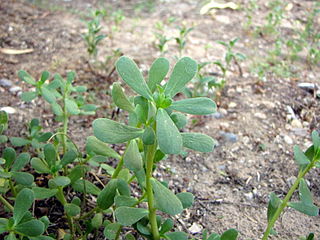
Portulaca oleracea is an annual succulent in the family Portulacaceae.
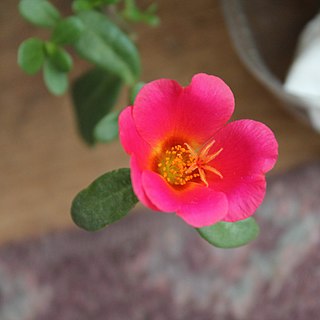
Portulaca is a genus of flowering plants in the family Portulacaceae, and is the type genus of the family. With over 100 species, it is found in the tropics and warm temperate regions. Portulacas are also known as the purslanes.

The Portulacaceae are a family of flowering plants, comprising 115 species in a single genus Portulaca. Formerly some 20 genera with about 500 species, were placed there, but it is now restricted to encompass only one genus, the other genera being placed elsewhere. The family has been recognised by most taxonomists, and is also known as the purslane family. It has a cosmopolitan distribution, with the highest diversity in semiarid regions of the Southern Hemisphere in Africa, Australia, and South America, but with a few species also extending north into Arctic regions. The family is very similar to the Caryophyllaceae, differing in the calyx, which has only two sepals.

Claytonia perfoliata, commonly known as miner's lettuce, rooreh, Indian lettuce, or winter purslane, is a flowering plant in the family Montiaceae. It is an edible, fleshy, herbaceous, annual plant native to the western mountain and coastal regions of North America.
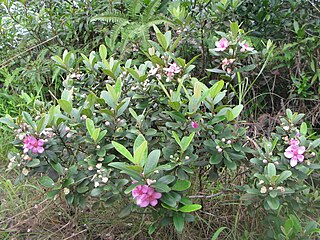
Rhodomyrtus tomentosa also known as rose myrtle, is a flowering plant in the family Myrtaceae, native to southern and southeastern Asia, from India, east to southern China, Hong Kong, Taiwan and the Philippines, and south to Malaysia and Sulawesi. It grows in coasts, natural forest, riparian zones, wetlands, moist and wet forests, bog margins, from sea level up to 2400 m elevation.

Portulaca grandiflora is a succulent flowering plant in the purslane family Portulacaceae, native to southern Brazil, Argentina, and Uruguay and often cultivated in gardens. It has many common names, including rose moss, eleven o'clock, Mexican rose, moss rose, sun rose, table rose, rock rose, and moss-rose purslane. Despite these names and the superficial resemblance of some cultivars' flowers to roses, it is not a true rose, nor even a part of the rose family or rosid group; rather, it is much more closely related to carnations and cacti.
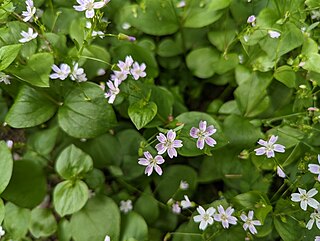
Claytonia sibirica is a flowering plant in the family Montiaceae, commonly known as pink purslane, candy flower, Siberian spring beauty or Siberian miner's lettuce. A synonym is Montia sibirica. It is native to Aleutian Islands and western North America and has been introduced into parts of Europe and Scandinavia.

Rhus integrifolia, also known as lemonade sumac, lemonade berry, or lemonadeberry, is a shrub to small tree. It is native to the Transverse and Peninsular Ranges and the South Coast regions of Southern California. This extends from Santa Barbara County and the Channel Islands to San Diego County and extending into north-central Pacific coastal Baja California and its offshore islands such as Cedros Island.

Talinum paniculatum is a succulent subshrub in the family Talinaceae that is native to much of North and South America, and the Caribbean countries. It is commonly known as fameflower, Jewels-of-Opar, or pink baby's-breath.

Lewisia brachycalyx is a species of flowering plant in the family Montiaceae, known by the common name short-sepal bitter-root or shortsepal lewisia. It is native to the mountains of the southwestern United States and Baja California, where it grows in moist habitat such as meadows.

Veronica peregrina is a species of flowering plant in the plantain family known by several common names including neckweed, American speedwell, purslane speedwell and hairy purslane speedwell. It is native to the Americas, and is known on other continents as an introduced species and a common weed. It can be weedy in its native range as well, growing on roadsides, on fields, and in other disturbed habitat. It is an annual herb growing from a taproot. The two subspecies are defined generally on the basis of hairiness: ssp. xalapensis is coated in glandular hairs and ssp. peregrina is a hairless variety. The plant produces erect stems up to about 30 centimeters tall. The leaves vary in shape from linear to lance-shaped to spoon-shaped with smooth or serrated edges; the lower leaves are borne on petioles. The inflorescence is a loose terminal raceme of flowers and lance-shaped bracts. The flowers are generally white and 2 or 3 millimeters wide.
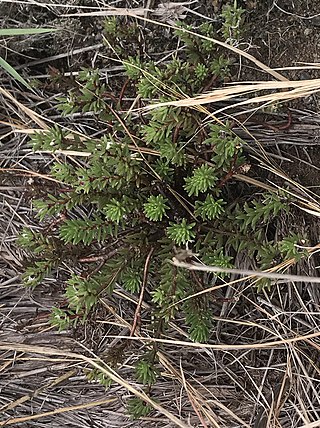
Portulaca sclerocarpa is a rare species of flowering plant in the purslane family known by the common names 'ihi makole and po`e. It is endemic to the Hawaiian islands, where it is known only from the island of Hawaii and an islet off of Lanai. Ten occurrences exist for a total of over 1000 individuals. It is a federally listed endangered species of the United States.

Silene lanceolata is a rare species of flowering plant in the family Caryophyllaceae known by the common names Kauai catchfly and lanceolate catchfly. It is endemic to Hawaii, where it is known only from Oahu, Molokai, and Hawaii, having been extirpated from Kauai and Lanai. It is threatened by the degradation of its habitat and it is a federally listed endangered species of the United States.

The flora of the U.S. Sierra Nevada alpine zone is characterized by small, low growing, cushion and mat forming plants that can survive the harsh conditions in the high-altitude alpine zone above the timber line. These flora often occur in alpine fell-fields. The Sierra Nevada alpine zone lacks a dominant plant species that characterizes it, so may or may not be called a vegetation type. But it is found above the subalpine forest, which is the highest in a succession of recognized vegetation types at increasing elevations.

Braya pilosa is a long-lived perennial flowering plant of the mustard family known by the common name hairy braya. It was first found by Sir John Richardson in 1826 during an expedition in search of the Northwest Passage. It wasn't found for 154 years, between 1850 and 2004.

Portulaca molokiniensis, known also as 'ihi, is a succulent plant endemic to Hawaii. This plant is federally listed as an endangered species. It has small yellow flowers and when grown from seed may produce a caudex. This plant is easy to propagate.

Portulaca lutea, the native yellow purslane, is a species of Portulaca that is indigenous to all of the main islands of Hawaii except for Kaua'i and is widespread throughout the Pacific Islands.

Portulaca umbraticola, also known as the wingpod purslane, is an annual or short-lived perennial succulent in the genus of flowering plants Portulaca.
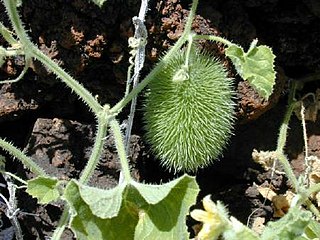
Cucumis dipsaceus, also known as Arabian cucumber or hedgehog cucumber, is an annual climbing herb that can be found in tropical and arid locations. The plant is native to eastern Africa, first found in Sudan, southern Egypt, and Ethiopia. The developed fruits of the plant change from green to yellow and contain many seeds. The hairs that cover the oblong fruits nickname this species the “hedgehog cucumber”.

Hibbertia pilosa, commonly known as hairy guinea flower, is a species of flowering plant in the family Dilleniaceae and is endemic to the southwest of Western Australia. It is an erect or sprawling shrub that typically grows to a height of 0.3–1.5 m and has leaves with long, soft hairs. The flowers are yellow with one or two densely hairy carpels from September to December. The species was first formally described in 1845 by Ernst Gottlieb von Steudel in Lehmann's Plantae Preissianae. The specific epithet (pilosa) means "pilose", referring to the leaves.




















